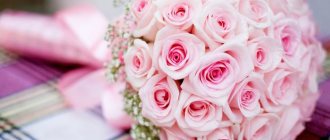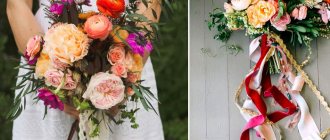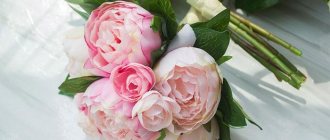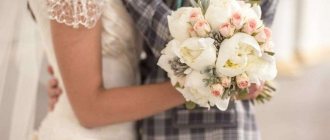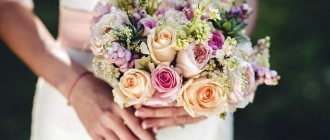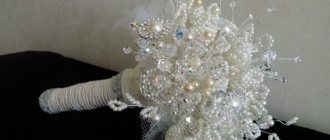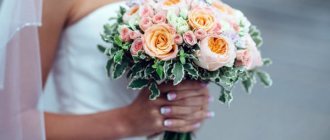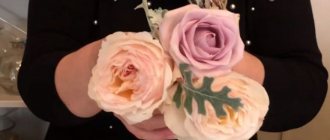How many times in a girl’s life are there big, beautiful and solemn events? Well, if you think about it, then several. And one of them is a wedding. A wedding is a magnificent and solemn event that every woman usually remembers throughout her life. To make this day memorable for everyone - everyone - everyone, the bride pays attention to every little detail. And every little thing or detail plays a special role at the wedding.
And a bouquet of flowers is the most important element that can be safely attributed to the continuation of the bride’s outfit. Flowers are with the bride all day, they emphasize her figure, complement the wedding image, and if the wedding is themed, then they also emphasize the theme. Also, a bouquet of flowers for the bride will help to express something interesting about the bride herself, talk about her feelings for the groom and simply express the unspeakable.
Disheveled
Disheveled bouquets have only recently come into fashion, but have already firmly taken their place among bouquets. An interesting detail in them can be not only flowers, but also their color - the trend of naturalness has also won the hearts of flower industry masters. Pale blue and soft pink, peach, cream pastel colors, diluted with fresh greenery, rich natural shades of burgundy, ocher - these colors are popular in wedding bouquets.
Silk ribbons and lace are another stylish and appropriate addition to such a bouquet. This bouquet looks good at weddings in a rustic or boho style, but it is also quite suitable for a classic look, if you do not overload it with a too pretentious composition of colors and shades. Feel free to use in your bouquet not only classic peonies, delphinium, peony roses or dahlias, but also exotic lavender, ferns, tulips, berries, flowering branches of bushes and trees, almost any flowers and plants. You can add wildflowers, spikelets, and feathers to the bouquet. It should be remembered that it is quite voluminous, so the dress in the image should not be too fluffy and with discreet trim so that the whole image does not look too massive.
How to choose “your” wedding bouquet?
The choice of bouquet depends on many factors:
- budget
- season
- favorite and least favorite flowers
- wedding style
- image of the bride
However, you should start not by choosing a specific form of bouquet, flowers, etc., but by choosing a competent florist who will help you decide on your desires and then make them come true. This is especially true for brides who want an original, designer bouquet for themselves - here EVERYTHING will depend on the professionalism of the florist. Some brides believe that they can even go to the nearest flower stall to pick up a bouquet. However, the choice there is extremely poor, and the storage conditions for flowers leave much to be desired. There is a big risk that the purchased bouquet will not “live” even for a couple of hours.
Daria Vazhenina:
“When choosing “your” florist, pay attention first of all to his work. The type of your bouquet will directly depend on the qualifications and capabilities of the florist. If the master is not professional enough, then by choosing one thing, you may end up getting something completely different. In a good salon, each florist has his own personal portfolio, not a general one. A florist is the same as an artist: he sees differently and treats flowers in a special way. If a specialist knows a lot about flowers and speaks about them with trepidation and care, most likely your bouquet will delight you and will last for more than a day (or maybe more than a week). I also advise you not to forget about the reviews of other brides: read, don’t be lazy. If you find a florist who is your soul mate, then your bouquet will be perfect! The choice of the bouquet itself primarily depends on your preferences, style and theme of the wedding, and your image. Much depends on the character of the bride herself: if she has a bright personality, energy is overflowing, I prefer to emphasize this feature with an unusual bouquet, rather than hide the uniqueness of the girl behind the severity of flowers. Show the florist sketches of wedding decor or examples of design, explain the style and theme of the celebration. Bring with you a photo of your dress (preferably the one you are wearing). The florist will show you approximate options for bouquets and tell you what will suit you best. When choosing a wedding bouquet, listen to your heart. Girls have a very keen sense of nature and intuitively choose the one bouquet that will accompany them throughout their wedding day.”
Classic round
A round bouquet is a classic version of a bridal bouquet - universal and suitable for any look, but to make it look stylish, do not overload it with rhinestones or other unnecessary decorations. With a fairly diverse composition of colors, it is better to decorate the leg with a simple ribbon and light lace trim, a small pendant or brooch. Inserts from succulents, proteas, artichokes, and other exotics will add exoticism to the bouquet. A bouquet can consist of one type of flower, but variety looks most advantageous: large and small buds, selected by color and shape.
A bouquet that will not wither
Newlyweds who choose such unusual options do not have to worry about this.
Wedding composition using kanzashi technique
This type of needlework made from satin ribbons was invented in Japan. The bouquet is usually spherical in shape.
The petals are connected with a thread and attached to a base - a ball of polystyrene foam, polyurethane foam or crumpled newspapers. The bouquet will be unique and memorable.
Bride's bouquet of sweets
A relatively simple variation of an edible bouquet, it’s easy to make yourself.
Craftswomen collect both classic-shaped bouquets and more whimsical compositions - baskets, swan couples and gazebos with couples in love.
From fruits and vegetables
A fun and original version of a wedding bouquet that allows you to use any details: from tropical fruits to seasonal vegetables. For a bride who leads a healthy lifestyle, a bouquet of lettuce, broccoli and celery can be collected. For a bright, extravagant person - from tangerines, paprika, cut pomegranate, small pumpkins. You can assemble the bouquet yourself and then eat the ingredients.
When choosing a bouquet, you need to take into account, first of all, the individuality of the newlyweds and the quality of the composition and materials. This accessory is not a trifle; it must at least remain in the memory and in the photo album.
Bouquet-ball
The ideal flower ball on a comfortable loop handle is the choice of those who do not like banalities and also want to add some zest to their look. It all depends on the composition of the flowers. This bouquet is convenient to wear as an elegant handbag, and the overall style of the floral arrangement does not require a specific celebration format. You should remember about the possible technique for composing such bouquets: on a wet sponge and on a dry sponge. You can use a larger list of flowers on a wet sponge, but due to improper assembly or improper handling of the bouquet, it may fall apart or leak, so be sure to prepare a duplicate bouquet for yourself. On a dry sponge the ball will last longer. Usually, very durable flowers are chosen for such balloon bouquets: for example, carnation or eustoma, craspedia or bush rose.
Assembly technique
The first thing to consider is the method of creating a floral composition. Its durability, convenience for the bride and composition depend on this. The most common techniques in wedding floristry:
- assembly on their stems;
- installing flowers in a porta bouquet holder;
- taping and splinting.
The arrangement “on its own stems” looks fresh and natural. It belongs to the leading trends of modern floristry. It is assembled in a spiral, less often in parallel, technique and can be of any size or shape - from a small hemisphere to a luxurious cascade. It is quite easy to learn how to compose it.
The disadvantage of the technique is that the plants are left without water for a long time and begin to wither. Therefore, the arrangement “on its own stems” has to be “soldered off” right during the wedding process, which is not very convenient. The solution is to use resistant plants that do not require constant moisture. But this significantly limits the flower assortment. In addition, lush compositions often have a voluminous handle due to the large number of stems. Holding such an accessory in your hand is difficult and uncomfortable.
The portbuketnitsa solves all of the above problems. This device, which looks like a microphone, consists of a thin, comfortable handle and a round frame with a moisturizing sponge (piaflor). Flowers in a porta bouquet receive water and a nutrient solution, maintaining freshness for several days. The device not only prolongs the life of the buds, but also allows you to create the most complex compositions from them, maintaining their original shape for a long time.
However, the size of the arrangements on the porta bouquet is limited. It will not be able to hold and saturate a large number of plants with water, which will begin to fall out at the slightest movement or will quickly wilt due to lack of moisture.
A composition of taped flowers is the most complex and expensive. The buds are cut from the stems and attached to the wire using tape. Then they are either assembled into a traditional spiral composition or grouped on a special frame. For moisture-loving plants, the cut is wrapped in a piece of cotton wool soaked in water and a supporting composition. Thanks to this, the arrangement remains fresh at least until the end of the wedding, and sometimes much longer. It also has the greatest strength and never disintegrates.
The taping technique is difficult for beginners; it requires professional knowledge and skills. When making your own wedding accessory, it is better to avoid it.
Garden or field
A simple and light bouquet without artificial inserts and flowers - wildflowers, light fragrant herbs, ears of corn and dried flowers, garden cut flowers. It’s as if nature itself creates a garden or field bouquet. It is very important to play with the line between an ordinary bouquet of wildflowers and an elegantly assembled floral masterpiece. You can add daisies, hydrangeas, peonies, decorative sunflowers, thistles, succulents, and a large amount of greenery to the bouquet. Branches with berries, fruits, cotton, cones for a winter wedding, and ears of corn will look great as an unusual addition. This is a bouquet for a bride in a rustic or country style, and for a cozy wedding in the forest, for a family painting in the registry office: without pretension or pathos, but with zest and warmth.
Form of bouquet arrangement
This is the most important parameter; the effect produced by the bride on others depends on it. There are several key rules:
- short girls only need compact arrangements;
- with curvaceous figures, the bride needs to choose a large bouquet with predominant vertical lines;
- a princess-style dress and a voluminous floral accessory are incompatible;
- The simpler the outfit, the more unusual the floral design can be.
Hemisphere
Arrangements of a semicircular shape with a dense, geometrically regular “cap” can be called timeless classics of the wedding genre. They are always in fashion, or rather beyond its whims. A round bridal bouquet is universal and suitable for any girl, regardless of height, build and color type.
It’s hard to name a dress style that doesn’t look good with a hemispherical composition. However, A-line styles or those with a full, multi-layered skirt especially benefit from this “neighborhood”.
“Hemisphere” is harvested both on its stems and on the porta bouquet. In the first case, the composition can be freer, as if “disheveled”, with plants placed at different heights. In the second, the boundaries are correct and clearly defined, complete symmetry is maintained.
Typically, small flower buds are used for round arrangements.
Cascade
Majestic compositions of a cascading shape, in which part of the flowers are directed downwards and form an inverted triangle, are suitable only for tall brides. The rest will be lost against the backdrop of buds of different shapes, sizes and textures falling like a stormy stream.
The “cascade” consists of a round “cap” and the so-called “tail” of plants on long stems, climbing grasses and flexible branches of shrubs. Most often, it is assembled on a portaquet or using a taped technique - this makes it easier to form a drooping silhouette. Although recently varieties “on their own stems” have appeared.
Cascading arrangements look good with a classic long, fitted dress.
A drop
A compact version of the “cascade”, more convenient and practical. It can consist solely of flowers or be combined with greenery. Unlike the “cascade”, the “drop” is often collected from one type of plant. Roses, lilies, orchids, gardenias and eustoma are ideal for her.
“Drop” is good for a palace or romantic style wedding celebration. It is best to assemble the composition on a bouquet holder, and also prepare a “double” for throwing to your girlfriends.
Rod or scepter
It consists of elongated flowers and plants with powerful stems - calla lilies, single-headed roses, eucharis, amaryllis, delphinium. They are assembled using a parallel technique, without crossing each other.
A rather bulky “wand” is usually worn on the bend of the elbow. It is recommended for brides who prefer a formal trouser or skirt suit to a traditional dress.
Florists note that the accessory, reminiscent of a royal sign of power, is suitable only for girls with a strong-willed, purposeful character; in the hands of others it will look ridiculous.
Vegetative composition
It is also called the “ruffled” or European free-form arrangement. Vegetative style is the main trend in modern wedding floristry, striving for natural naturalness and beauty. The plants in the bouquet arrangement should look as if they were still growing in the meadow or garden and had not been touched by human hands.
Such a wedding bouquet has practically no form, in its traditional sense. An asymmetrical arrangement of elements, grouping by type or shade, and pronounced line dynamics predominate. A contrast is required between very large focal buds and small filler inflorescences, openwork and dense greenery, curved and straight plants.
“Rastropysh” is appropriate for a wedding in a rustic and eco-style, boho, Provence, a celebration of a marine, fairy-tale or botanical theme.
Depending on the size and splendor, it will suit both a very petite girl and someone with model height.
Vegetative compositions go well with flowing, loose-fitting dresses, Greek tunics, sundresses and folklore wedding dresses.
Glamelia
A huge artificial flower consisting of many living petals. Assembled using floral glue or wire staples. It looks very elegant and unusual, but is used quite rarely due to the complexity of assembly and fragility.
The first glamelias were made at the end of the 19th century from the petals of gladioli. Florists sought to resemble the camellia, which was popular at that time, hence the name of the technique. Today, the term “glamelia” refers to a wide range of decorative works - from realistic imitation of fresh flowers, to frames lined with petals and fantasy compositions.
Florists do not limit themselves when choosing “donor” plants. For example, giant wedding accessories made from rose buds, called rosamelia, are very popular.
To create you will need:
- approximately 20 single-headed roses;
- technical wire D 0.5 mm;
- floral glue and tape;
- decorative cord;
- a narrow cone made of cardboard, a large bead and a bamboo skewer.
Carefully separate the pink petals from the receptacle. We remove the whole bud, and then divide it into components. We sort them by size: small, medium and large.
Place the petals on a paper towel and cover it with a damp cloth on top. We cut the wire into fragments 4 and 8 cm long. We bend them, making square pins according to the principle of staples for a stapler. There should be a lot of fasteners - both short and long - to assemble different tiers of rosamelia.
For a whole rose, remove the sepals and outer petals, stopping the tightly closed bud.
This is the basis of the future rosamelia. Next, we wrap it around a row of medium-sized petals, attaching them to the core with short pins. You can take several pieces at a time to speed up the assembly process and make the decorative flower bouquet more magnificent. Moving away from the center, we take increasingly longer hairpins and larger petals.
Having assembled the composition of the required volume, we move on to decorating its back part, which is not nearly as beautiful as the front part. We cut out a circle of suitable diameter from thick cardboard and make a hole in it for the rosemelia handle. Glue it to the bottom of the flower and cover the edges with petals.
Let's make an analogue of sepals from ivy. We will add a few more branches to the stem of the base rose to gain the desired thickness. Wrap everything with several layers of tape. Roll a long narrow cone out of cardboard.
Glue a skewer into it, and attach a bead to its tip with hot glue. The result will be a blank for a spectacular handle. We wrap everything together with tape to align and mask the joints. Then we decorate the handle with a cord of the same shade as the rosemelia.
We put the cone on the stems and fix it at the base of the flower with floral glue.
The bride's bouquet, called glamelia, is ready.
This is what it will look like on your wedding day:
Biedermeier
A variation of the classic round bridal bouquet. It has a characteristic feature: flowers of bright contrasting shades are arranged in layers, forming something like a colorful striped ball. Having appeared in Germany in the middle of the 19th century, Biedermeier firmly won its place on the floristic Olympus and has not left it since then, only slightly changing its appearance.
The most convenient way to collect the “multi-colored ball” is on a porta bouquet holder. A device with a floral sponge already soaked in water is installed in a narrow vase so that the arrangement of a large number of buds does not tip over.
For the lowest tier we take small inflorescences: gypsophila, chamomile or, for example, white bush aster of the Monte Casino variety. We leave the greenery on the stems so that the flower strip becomes very dense, completely covering the piaflora base.
We make the next layer of spray roses “Lovely Lydia” in a rich pink color. Their stems should be slightly shorter than those of the aster and “look” slightly upward.
Using the same principle, we create the next two rings - from purple statice and yellow spray roses of the “Sphinx” variety. The crowning feature is the rainbow Biedermeier stephanotis, the favorite flower of the British royal family. The delicate petals of this plant can suffer from the slightest touch. Therefore, the inflorescences are carefully placed on a pin and, already held by it, are attached to the piaflor.
Ball (pomander)
The unusual spherical arrangement, a favorite of creative brides, originates from medieval vessels for fragrant herbs, incense and spices. These small, generously decorated round-shaped accessories that emit a pleasant aroma were designed to protect their owner from numerous infections and hide unpleasant body odors.
Flower pomanders became popular at the beginning of the 20th century. They were used to decorate interiors for various celebrations, including weddings. A little later, the idea arose to use “live” accessories as a bridal bouquet.
The pomander is worn on the elbow or in the lowered hand, holding it by a loop of wide textile tape. It suits graceful girls of short stature in classic-style dresses.
The pomander is based on a ready-made piaflora ball. To attach the holder to it, use a floral wire pin. It is threaded through a knotted ribbon, woven into one rod and taped, and then the ball is pierced and, bending on the other side, the end is inserted back into the piaflor.
We decorate the sphere, pre-soaked with water, with flowers. For example, bush roses and exotic anigozanthus. Or sprigs of variegated pitosporum.
Glamelia
To collect a glamelia bouquet, the flowers are separated into petals and then collected into one large bud using a special technique. Usually roses or lilies, as well as orchids or tulips are used for a bouquet. You can also combine different petals in color and shape from different flowers. This bouquet is a real indicator of skill, because not everyone can make it tastefully. This bouquet will highlight the classic image of the bride and will help you highlight the lace trim or layering of the dress. The bride's elegant accessories and jewelry will help highlight the bouquet.
Types by season
One of the important criteria when choosing is the time of the wedding. Spring ones are most often gentle and neat. They can include tulips, daffodils, lilies of the valley, irises, hyacinths, and mimosa. Options with flowering trees/shrubs (apple tree, cherry tree, bird cherry, lilac) are possible. Summer ones are usually full of colors. They can use wildflowers: peonies, daisies, lilies, poppies, sunflowers, and various herbs.
For autumn they like to use all shades of yellow and orange. To add more brightness, you can include rowan or viburnum berries, yellowed leaves and dried flowers. Traditional flowers are: dahlias, marigolds, asters, hydrangeas. Winter varieties of bridal bouquets combine flowers that are available all year round: roses, orchids, chrysanthemums, gypsophila, gerberas. Spruce and thuja branches look great in winter.
Creative
Creative bouquets are solutions for stylish and daring brides. Bouquets do not necessarily have to be made of fresh flowers: these can be paper flowers, feathers, brooches, even garlands of light bulbs collected in the form of a bouquet. They fit wonderfully into various formats - both thematic images and even classic, elegant images. This is no longer just a bouquet, but a bright and stylish accessory. But when choosing it, remember that it should suit not only the style of the wedding, but also your image.
Try to ensure that the bride’s bouquet matches not only your image, but also the style of the wedding as a whole, and the image of the groom.
What color should the bride's bouquet be?
Preparing for a wedding is a pleasant and anxious process that takes a lot of time from the future bride. Flower arrangement is one of the important components of appearance. It is matched to the style of the dress, its color, height and build of the bride, and also takes into account the theme of the wedding and the time of year. And it’s simply the bride’s personal preference and taste that makes her choice in favor of one or another floral masterpiece.
of bridal bouquets on our website.
: for certain seasons of the year, for specific wedding themes, in different shapes and colors. By ordering a bouquet in advance, you will receive it at the right time and just in time for the event.
Bridesmaid's bouquet for a wedding photo of the most beautiful options
Witnesses (aka groomsmen) are no longer required at a modern wedding, as they were in the last century. However, many newlyweds prefer not to give up this beautiful custom and assign special roles to the groom's friend and the unmarried bridesmaid. In this case, the question often arises whether the witness needs a bouquet, and if so, what should it be like. When answering this question, you should start from several principles at once:
- Flowers should be harmoniously combined with the image of the witness;
- It is necessary to comply with the color scheme chosen for the celebration;
- The bouquet should not be too heavy and voluminous;
- The composition should be made in the same style as the bride's bouquet, boutonnieres of the groom and witness.
In the case when the witness’s bouquet is used as a backup, it is not at all necessary to order an exact copy of the composition. It is enough that it complies with the above principles and fits harmoniously into the overall wedding concept.
How many colors should there be
According to European tradition, the number of fresh flowers in any bouquet should be odd , the same applies to the wedding composition. However, how much is it?
Do not chase an overly lush option. When thinking about quantity, there are a few other things :
- The weight of the composition will depend on the number of plants included in it. The bride must not part with the flowers all day, literally not letting them out of her hands for a minute. Imagine her state in the evening: fatigue from the bouquet is guaranteed!
- Quality and freshness . The specificity of a floral arrangement for a newlywed is that the flowers must remain beautiful and fresh for a long time, without being in water. Additional heaviness of the composition is given by a sponge soaked in water, into which flowers are usually fixed. If there is a large number, the stems may fall out of the holes, and the flowers, not communicating with water, can quickly lose their appearance.
- The number of plants will also depend on the type of bouquet and its content. If you use small flowers, you will need more of them. The optimal number for a medium-sized bouquet would be 5-7 flowers.
Important! Don’t forget about additional components, because sprigs of greenery and berries will also add volume and weight to the composition.
A wedding bouquet as a gift to the newlyweds from the guests PHOTO
The guests, and the bride herself, face the difficult choice of the right bouquet for the wedding. Having received an invitation, each guest wonders not only about the gift, but also about flowers for the newlyweds. Is it necessary to give flowers at all, and if so, which ones are best to choose? Such questions torment the mind of almost every invitee. The answer is obvious: it is virtually impossible to imagine a wedding without flowers.
After all, bouquets are almost everywhere, starting with wedding flowers in the bride’s hands, on the festive table and ending with car hoods and the groom’s jacket. Of course, there are no strict rules of etiquette that oblige guests to come to the celebration with certain flowers, and the newlyweds certainly won’t have time to keep track of who gave the bouquet and who didn’t. Therefore, it’s just a matter of personal choice, but a beautiful bouquet for a wedding is an irreplaceable attribute.Pomander - ball on a ribbon
Wedding bouquet in the form of a ball on a ribbon or braid. It exudes lightness and ease; such a bouquet is ideal for a soft and light bride. Most often, roses, carnations and chrysanthemums are used in its creation.
pros
- Original appearance.
- Although this bouquet has a frame, it is not heavy at all.
- Easy to make - you can make this bouquet yourself at home.
- Variability in size: a pomander can be either a standard size for a wedding bouquet or very small, and in this case it can serve as a bridesmaid’s bouquet.
Editor's choice: A funny modern bride price scenario. Photo review
Minuses
- There is no base for the bouquet, which makes it impossible to pick it up without crushing the flowers.
- Fragility: it is difficult to keep a pomander in its original state for a long time, since it is impossible to touch it without damaging any flower. Therefore, if you suddenly need to put it down, you can immediately say goodbye to the original appearance of the bouquet.
Originality - how to highlight the image of the bride
Recently, original types of wedding bouquets for the bride made not from real flowers, but from any other materials, have become increasingly popular.
The original ones most often use:
- foamiran;
- from beads;
- feathers;
- beads, rhinestones;
- butterflies from any material;
- ribbons;
- cones;
- corrugated paper;
- fruits and vegetables;
- decorations made of polymer clay (flowers, leaves, butterflies, etc.);
- candies;
- lace;
- buttons;
- shells.
Monobouquets and prefabricated ones
Depending on whether only flowers of one type or several will be added, they are divided into mono-bouquets and prefabricated (mixed) bouquets. Mono bouquets seem more classic, simple and minimalist, while mixed bouquets seem more unique, bright and unusual.
Flowers in a mono-bouquet can be either the same or similar shade, or different. Leaves and various accessories can be added to bouquets consisting of one type of flower.
Flowers in prefabs are selected according to the length of the stem. Mixed ones can use flowers of the same shade (or the same degree of saturation, for example all pastel colors), or multi-colored ones.
